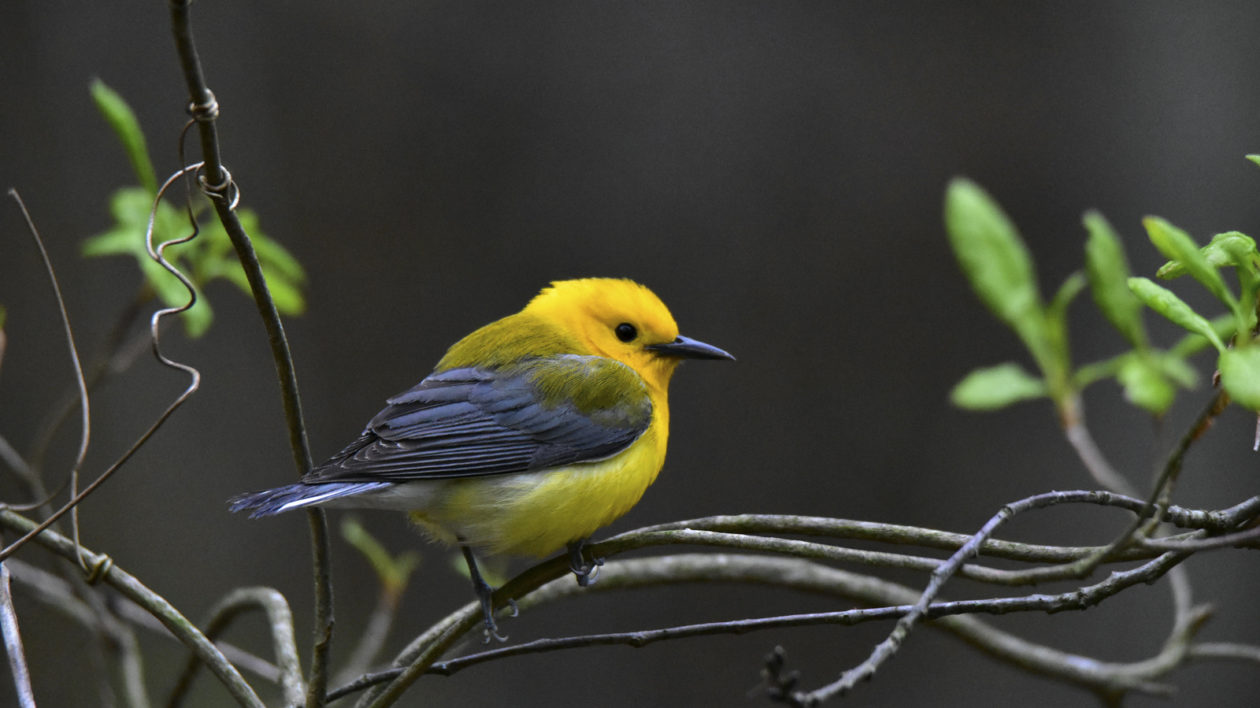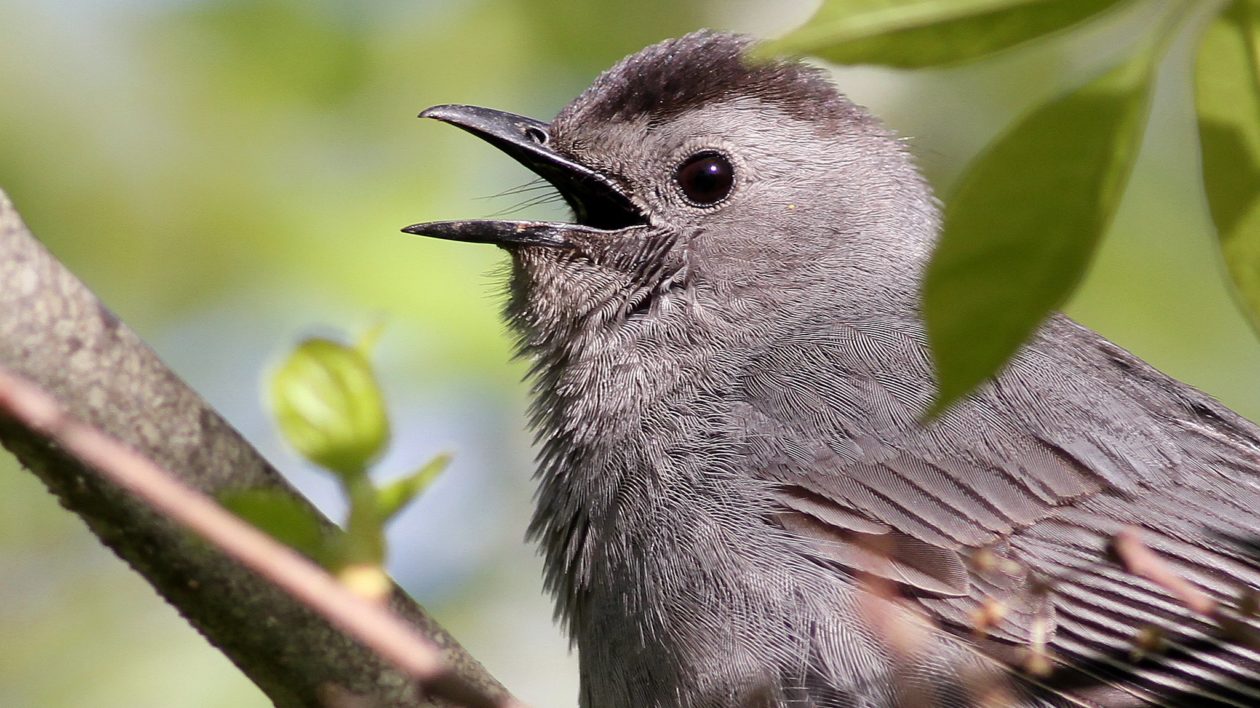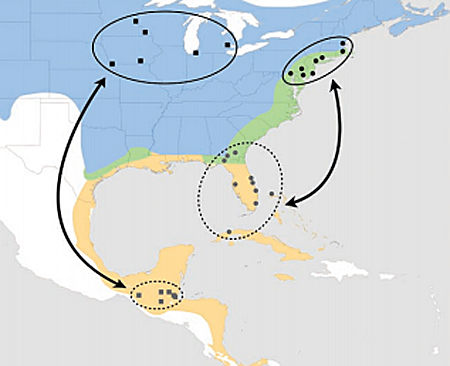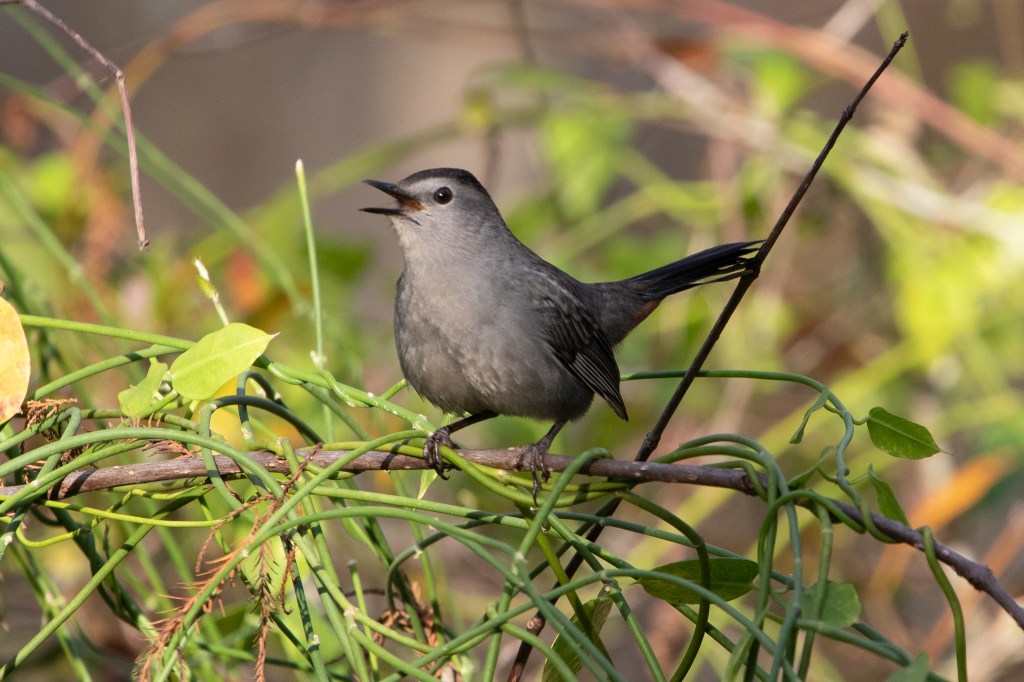Consider the gray catbird: the tropical long-distance migrant that may well be nesting in your backyard this summer.
Gray catbirds are common, so you may not pay them much attention. But look into the research, and you’ll find that this backyard bird is full of surprises. Let’s take a closer look.
As I write this, a gray catbird is singing in my backyard.
It arrived here in New Jersey several weeks ago and may already be building a nest with its mate somewhere in the neighborhood.
I am wondering where my catbird spent its winter – and whether this is the very same catbird that was in my yard last summer. Research on catbirds can help answer these questions.
Every spring, dozens of species of migrant songbirds make their way north from the tropics to settle into nesting habitats across North America. Indeed, half of all North American birds spend their winters south of the U.S. border – from Mexico through South America.
Most of these species are habitat specialists and we might see them in our backyards only briefly during migration as they make their way to more remote places.

The gray catbird, on the other hand, is a migrant from the tropics that is quite happy to claim a breeding territory in a wide variety of shrubby habitats, including suburban backyards.
The catbird singing in your backyard this spring is likely the same one that was there last year. Individual catbirds (and numerous other species) return to the same habitat patch to nest year after year, as long as they are fortunate enough to survive from one season to the next. Studies have shown a roughly 60 percent annual survival rate for catbirds.
If your backyard catbird has a lucky streak, you could see the same bird coming back for many seasons. The longevity record for a catbird is 17 years, 11 months.
This nearly 18-year-old bird was caught and banded as a young of the year in Maryland and miraculously encountered again by banders those many years later in New Jersey.
Banding can confirm the age of birds and also confirm that the bird in your backyard this year is the same one that was there last year.
Participants in programs like Neighborhood Nestwatch can observe their backyard catbirds wearing unique combinations of colored leg bands. These identify each bird as an individual and can be viewed with binoculars. For this project, researchers and participants alike can make observations on the identity and longevity of their catbirds.
Catbirds nest in 46 of the lower 48 United States and across southern Canada. They spend the winter across an equally broad area. A proportion stay in the U.S., where they primarily occupy the Gulf Coast and Florida. Some hearty individuals hang in there as far north as New Jersey.

Others go further south to the tropics – to the forests of Mexico, the Caribbean and Central America. There, they share the woods with jaguar, tapir, fer-de-lance and toucans.
Catbirds return to the same site on the wintering grounds every year as well. Your backyard catbird might spend the winter in the shadow of Mayan ruins in Guatemala or perhaps in the Florida Everglades.

We can make an educated guess on where your backyard catbirds spend the winter thanks to a recent analysis of banding records along with the use of tracking devices.
What this work tells us is that if a catbird breeds in the upper Midwest, it is more likely to be spending the winter in Central America. If it nests in the mid-Atlantic and New England, your catbird is likely spending the winter in Florida or the Caribbean.
As more studies like this one are carried out, we will have a further refined picture of “migratory connectivity” between nesting and winter sites. And we will be able to make even better guesses about where our backyard catbird might be next winter.
“A Few Raisins Give Him the Greatest Delight”
If you want to kick things up a notch for your backyard catbirds this summer, in addition to providing water, you can also offer them fruit.
As the poet Mary Oliver observes in her poem “Catbird”: “But a few raisins give him the greatest delight.”
One of the pleasures of a birding holiday in the tropics is watching birds at fruit feeders. After hours of seeking difficult-to-see skulking birds of the undergrowth and fast-flitting birds of the high tree tops, birding respite can be found at lodges and cafes that maintain fruit feeders for birds. Dozens of species of brightly colored birds come into easy view to eat banana, papaya and citrus at close range.
Catbirds bring a bit of this culture back with them from the tropics and are among the few birds at our northern latitudes that will readily eat soaked raisins, sliced orange and even grape jelly.
Back to my well-fed catbird. Is he the same bird as last year? Without banding him, I can’t know for sure. But I do know that he will do everything within his power to return here.

And return from where?
Maybe it is time to combine science with imagination. The science tells me that he wintered somewhere in Florida or the Caribbean.
But for better spatial resolution, my imagination is saying the Zapata Swamp of Cuba. Listen to what he sounds like there (in the audio file) … and then listen for the catbird in your yard!




My family’s back yard in the Hyde Park section of Boston had nesting catbirds every summer, but I had not seen/heard a catbird in the Hebron, NH (Lakes Region) until this year. I have also seen/heard mockingbirds in the area in recent years. It would seem that both have extended their range northward.
I have catbirds every summer – I live close to Concord NH. Not surprised you have them as well. Not sure if they are the same ones every year, but they always nest in the same deciduous shrubs in our backyard. They are so verbal and chatty, and follow me around the yard vocalizing. They love the birdbaths but I haven’t fed them. Now that I know they like fresh fruits and grape jelly they are in for a treat!
I have a catbird nest right outside my LR window eggs hatched yesterday there are 4 birds…Mother seems to be patient with us humans…This is so great to watch these babies grow..
Third year in a row that we have Gray Catbirds eating Grape Jelly from our Oriole feeders here in Red Wing, Minnesota
I have them every year in Wescosville, PA. This Spring I saw 6 in my feeder tree at once when they returned. Either there are many more here now, or they each take numerous baths a day because almost every time I look out my windows, there is one bathing in either my birdbaths or my Koi pond. I love them!
Your catbird has been with me all winter I have been feeding her/him very well they love the suet I fix them with berries in it, they love the green grapes will eat the red if no seeds. They also feasted on fresh oranges, thistle and I get fruit pellets for the parrots so there is always those crumbles he loves them. They have 17 birdbaths to choose from so several can take a bath at the same time and no crowding. I expect you to take care and treasure them like I do and send them back to me in October. Thank you
Phaedra, we don’t have quite that many bird baths, but we treasure them, feed them, chat with them, and give them very safe, secretive nesting spots in our yard. I love your post so much. It’s good to think of all the bird lovers taking care of them while they’re away, north or south. I will hate to see them go a little bit less this year, but I will still miss them so much.
Dear Phaedra,
I love what you wrote. I am about to record a song that features our beloved Catbirds as well as other birds. It will be used to raise money for a Wildbird rescue.
Where are you? I take great care of “our” birds as well 🙂 They are here having a great time.
Leslie
My Catbird getting ready to migrate, fueling up with Suet. GoPro at the feeder.
https://www.youtube.com/watch?v=RQZinRY4lic
September 2014
I have had a pair in my back yard for the last 3 years,,near Syracuse, NY
Yes i have a pair of Catbirds in my backyard. They are nesting in a burning bush right outside my front window. I believe we had some last year, but have not been able to identify whether they are the same ones as last year. Love the information about them. Thank you for sharing.
This is my first year with catbirds! I hope they do return to see us in Yardley, Pa every year.
(the catbirds in my yard don’t squawk like that on your recording) they have a distinct multi sound call that reminds me of R2D2 with a mewing like a cat here and there which is delightful 🙂
I agree, today it struck me today while listening that the catbird singing sounds like R2D2.
The catbirds seem so friendly as compared to other birds – I can get within a few feet of them.
I like to mew at them.
I wonder if they would eat some raisins or grape jelly out of my hand.
I live in Hagerstown, Md.
There have been Catbirds in my yard my whole life (lived in same house for 52 yrs). This year there is one that sings at 3 a.m.
That’s probably a male Mockingbird that you hear at 3am. During mating season they usually sing in the middle of the night to get the attention of a mate, and mimic other bird songs like the Catbird. Both nest in similar areas too. I love to hear their songs of love at 2am!
Thank you Tina
Thank you! I love the Catbirds that visit me every year. Last year I called all around asking if I could participate in banding, as I have been so curious as to where they winter. I know that they are the same Catbirds as they stand beside me, especially when I sing to them.
Yes, the catbird indeed loves fruit. I have covered my strawberry plants with netting for this very reason.
I have really enjoyed the catbird singing in my back yard this year, mountains of western NC, but now I appreciate him much more.
I love the return of the cat bird to our coastal Maine island home. What a beautiful voice and diverse repertoire of songs. Thanks for the great article!